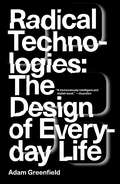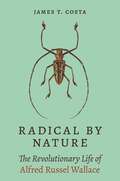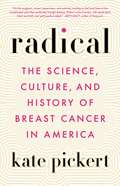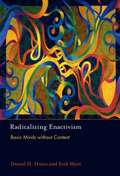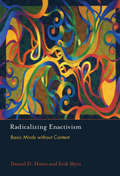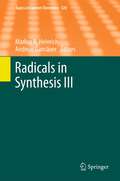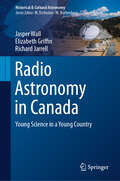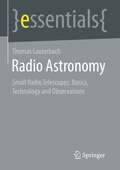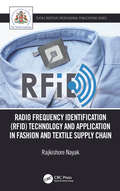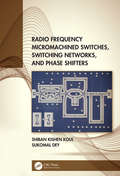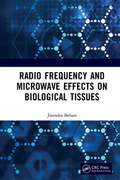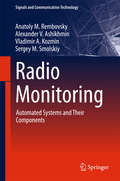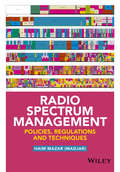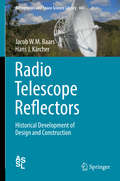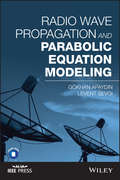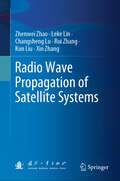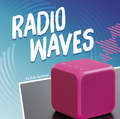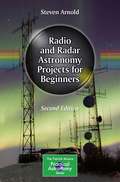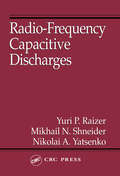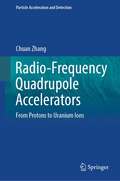- Table View
- List View
Radical Technologies: The Design of Everyday Life
by Adam GreenfieldA field manual to the technologies that are transforming our livesEverywhere we turn, a startling new device promises to transfigure our lives. But at what cost? In this urgent and revelatory excavation of our Information Age, leading technology thinker Adam Greenfield forces us to reconsider our relationship with the networked objects, services and spaces that define us. It is time to re-evaluate the Silicon Valley consensus determining the future. We already depend on the smartphone to navigate every aspect of our existence. We’re told that innovations—from augmented-reality interfaces and virtual assistants to autonomous delivery drones and self-driving cars—will make life easier, more convenient and more productive. 3D printing promises unprecedented control over the form and distribution of matter, while the blockchain stands to revolutionize everything from the recording and exchange of value to the way we organize the mundane realities of the day to day. And, all the while, fiendishly complex algorithms are operating quietly in the background, reshaping the economy, transforming the fundamental terms of our politics and even redefining what it means to be human. Having successfully colonized everyday life, these radical technologies are now conditioning the choices available to us in the years to come. How do they work? What challenges do they present to us, as individuals and societies? Who benefits from their adoption? In answering these questions, Greenfield’s timely guide clarifies the scale and nature of the crisis we now confront —and offers ways to reclaim our stake in the future.
Radical by Nature: The Revolutionary Life of Alfred Russel Wallace
by James T. CostaA major biography of the brilliant naturalist, traveler, humanitarian, and codiscoverer of natural selectionAlfred Russel Wallace (1823–1913) was perhaps the most famed naturalist of the Victorian age. His expeditions to remote Amazonia and southeast Asia were the stuff of legend. A collector of thousands of species new to science, he shared in the discovery of natural selection and founded the discipline of evolutionary biogeography.Radical by Nature tells the story of Wallace&’s epic life and achievements, from his stellar rise from humble origins to his complicated friendship with Charles Darwin and other leading scientific lights of Britain to his devotion to social causes and movements that threatened to alienate him from scientific society.James Costa draws on letters, notebooks, and journals to provide a multifaceted account of a revolutionary life in science as well as Wallace&’s family life. He shows how the self-taught Wallace doggedly pursued bold, even radical ideas that caused a seismic shift in the natural sciences, and how he also courted controversy with nonscientific pursuits such as spiritualism and socialism. Costa describes Wallace&’s courageous social advocacy of women&’s rights, labor reform, and other important issues. He also sheds light on Wallace&’s complex relationship with Darwin, describing how Wallace graciously applauded his friend and rival, becoming one of his most ardent defenders.Weaving a revelatory narrative with the latest scholarship, Radical by Nature paints a mesmerizing portrait of a multifaceted thinker driven by a singular passion for science, a commitment to social justice, and a lifelong sense of wonder.
Radical: The Science, Culture, and History of Breast Cancer in America
by Kate PickertThe science, culture and history of breast cancer as told by a reporter who survived it As a health-care journalist, Kate Pickert knew the emotional highs and lows of medical treatment well -- but always from a distance, through the stories of her subjects. That is, until she was unexpectedly diagnosed with an aggressive type of breast cancer at the age of 35. As she underwent more than a year of treatment, Pickert realized that the popular understanding of breast care in America bears little resemblance to the experiences of today's patients and the rapidly changing science designed to save their lives. After using her journalistic skills to navigate her own care, Pickert embarked on a quest to understand the cultural, scientific and historical forces shaping the lives of breast-cancer patients in the modern age.Breast cancer is one of history's most prolific killers. Despite billions spent on research and treatments, it remains one of the deadliest diseases facing women today. From the forests of the Pacific Northwest to an operating suite in Los Angeles to the epicenter of pink-ribbon advocacy in Dallas, Pickert reports on the turning points and people responsible for the progress that has been made against breast cancer and documents the challenges of defeating a disease that strikes one in eight American women and has helped shape the country's medical culture.Drawing on interviews with doctors, economists, researchers, advocates and patients, as well as on journal entries and recordings collected over the author's treatment, Radical puts the story of breast cancer into context, and shows how modern treatments represent a long overdue shift in the way doctors approach cancer -- and disease -- itself.
Radicalizing Enactivism
by Daniel D. Hutto Erik MyinMost of what humans do and experience is best understood in terms of dynamicallyunfolding interactions with the environment. Many philosophers and cognitive scientists nowacknowledge the critical importance of situated, environment-involving embodied engagements as ameans of understanding basic minds -- including basic forms of human mentality. Yet many of thesesame theorists hold fast to the view that basic minds are necessarily or essentially contentful --that they represent conditions the world might be in. In this book, Daniel Hutto and Erik Myinpromote the cause of a radically enactive, embodied approach to cognition that holds that some kindsof minds -- basic minds -- are neither best explained by processes involving the manipulation ofcontents nor inherently contentful. Hutto and Myin oppose the widely endorsed thesis that cognitionalways and everywhere involves content. They defend the counter-thesis that there can beintentionality and phenomenal experience without content, and demonstrate the advantages of theirapproach for thinking about scaffolded minds and consciousness
Radicalizing Enactivism: Basic Minds without Content
by Daniel D. Hutto Erik MyinA book that promotes the thesis that basic forms of mentality—intentionally directed cognition and perceptual experience—are best understood as embodied yet contentless.Most of what humans do and experience is best understood in terms of dynamically unfolding interactions with the environment. Many philosophers and cognitive scientists now acknowledge the critical importance of situated, environment-involving embodied engagements as a means of understanding basic minds—including basic forms of human mentality. Yet many of these same theorists hold fast to the view that basic minds are necessarily or essentially contentful—that they represent conditions the world might be in. In this book, Daniel Hutto and Erik Myin promote the cause of a radically enactive, embodied approach to cognition that holds that some kinds of minds—basic minds—are neither best explained by processes involving the manipulation of contents nor inherently contentful. Hutto and Myin oppose the widely endorsed thesis that cognition always and everywhere involves content. They defend the counter-thesis that there can be intentionality and phenomenal experience without content, and demonstrate the advantages of their approach for thinking about scaffolded minds and consciousness.
Radicals in Synthesis III
by Andreas Gansäuer Markus HeinrichBoron-Doped Diamond Electrodes for Electroorganic Chemistry, by Siegfried R. Waldvogel, Stamo Mentizi und Axel Kirste.- Modern Developments in Aryl Radical Chemistry, by Gerald Pratsch und Markus R. Heinrich.- Radical Additions to Chiral Hydrazones: Stereoselectivity and Functional Group Compatibility, by Gregory K. Friestad.- Hydrogen Atom Donors: Recent Developments, by Andreas Gansäuer, Lei Shi, Matthias Otte, Inga Huth, Antonio Rosales, Iris Sancho-Sanz, Natalia M. Padial und J. Enrique Oltra.- Radicals in Transition Metal Catalyzed Reactions? Transition Metal Catalyzed Radical Reactions? - A Fruitful Interplay Anyway Part 1. Radical Catalysis by Group 4 to Group 7 Elements, by Ullrich Jahn.- Radicals in Transition Metal Catalyzed Reactions? Transition Metal Catalyzed Radical Reactions? - A Fruitful Interplay Anyway Part 2. Radical Catalysis by Group 8 and 9 Elements, by Ullrich Jahn.- Radicals in Transition Metal Catalyzed Reactions? Transition Metal Catalyzed Radical Reactions?: A Fruitful Interplay Anyway Part 3: Catalysis by Group 10 and 11 Elements and Bimetallic Catalysis, by Ullrich Jahn.-
Radio Astronomy in Canada: Young Science in a Young Country (Historical & Cultural Astronomy)
by Elizabeth Griffin Richard Jarrell Jasper WallHere is the tale of Canada’s intriguing development of the science of Radio Astronomy. In 1946 the lone figure of Arthur Covington started monitoring the radio emission of the Sun, a programme that continues to this day. By the 1960s Canada had progressed to constructing two radio observatories at either ends of the country (the DRAO and the ARO), and universities were coming onboard. The story continues through the dire times for these and follows their fortunes and fates right up to the present, with Canada now playing key roles in billion-dollar international telescope projects. It concludes with the construction and operation of Canada’s own transformational telescope, CHIME. Anecdotes and images throughout the book liven the story.The authors—two practising astronomers—have painstakingly put together this fascinating story, drawing on first-hand experiences, valuable contributions from many colleagues, and the research of science historian, Richard Jarrell (1942-2013).This book fills a gap in the substantial literature on the history of radio astronomy. Carefully-researched by three experts and based on input by further experts in the field, it documents the extensive scientific and (especially) technical innovations of Canadian scientists and engineers. This includes the important Canadian absolute flux-density calibrations, the critical Canadian contribution to low-frequency radio astronomy and VLBI, and the long-running solar monitoring programme. Frank discussions about the excellent 46-m ARO telescope and its fate lead into considerations of Canada’s contributions to recent international projects – the JCMT, ALMA and the upcoming SKA. The book concludes with a description of CHIME, Canada’s own new-generation radio installation.Ken Kellermann, Senior Scientist Emeritus, National Radio Astronomy Observatory, Charlottesville, USA
Radio Astronomy: Small Radio Telescopes: Basics, Technology, and Observations (essentials)
by Thomas LauterbachRadio technology enables the extension of astronomical observations beyond light to other frequency ranges. This has led to the discovery of numerous cosmic radio sources, the physical causes of which are explained as well as how a radio telescope works. Even small radio telescopes can observe radiation from the Sun and other radio sources, as well as the 21-cm radiation from the Milky Way. Through interferometry, much higher resolution can be achieved than with individual radio telescopes. As a result, radio astronomical research can contribute to many current questions in astronomy, cosmology, and physics. This Springer essential is a translation of the original German 1st edition essentials, Radioastronomie by Thomas Lauterbach, published by Springer Fachmedien Wiesbaden GmbH, part of Springer Nature in 2020. The translation was done with the help of artificial intelligence (machine translation by the service DeepL.com). A subsequent human revision was done primarily in terms of content, so that the book will read stylistically differently from a conventional translation. Springer Nature works continuously to further the development of tools for the production of books and on the related technologies to support the authors.
Radio Frequency Identification: Technology and Application in Garment Manufacturing and Supply Chain (Textile Institute Professional Publications)
by Rajkishore NayakRadio Frequency Identification (RFID) Technology and Application in Fashion and Textile Supply Chain highlights the technology of Radio Frequency Identification (RFID) and its applications in fashion and textile manufacturing and supply chain management. It discusses the brief history, technology, and working of RFID including the types of RFID systems. It compares differences, advantages, and disadvantages of RFID and barcode technologies. It also covers application of RFID technology in textile and fashion manufacturing, supply chain, and retail, and RFID-based process control in textile and fashion manufacturing. It covers various applications of RFID starting from fibre manufacturing through yarn and fabric manufacturing; fabric chemical processing; garment manufacturing and quality control; and retail management. It offers case studies of RFID adoption by famous fashion brands detailing the competitive advantages and discusses various challenges faced and future directions of RFID technology.
Radio Frequency Micromachined Switches, Switching Networks, and Phase Shifters
by Shiban Kishen Koul Sukomal DeyRadio Frequency Micromachined Switches, Switching Networks, and Phase Shifters discusses radio frequency microelectromechanical systems (RF MEMS)-based control components and will be useful for researchers and R&D engineers. It offers an in-depth study, performance analysis, and extensive characterization on micromachined switches and phase shifters. The reader will learn about basic design methodology and techniques to carry out extensive measurements on MEMS switches and phase shifters which include electrical, mechanical, power handling, linearity, temperature stability, reliability, and radio frequency performance. Practical examples included in the book will help readers to build high performance systems/subsystems using micromachined circuits. <P><P> Key Features <li> Provides simple design methodology of MEMS switches and switching networks including SPST to SP16T switches <li> Gives an in-depth performance study of micromachined phase shifters. Detailed study on reliability and power handling capability of RF MEMS switches and phase shifters presented <li> Proposes reconfigurable micromachined phase shifters <li> Verifies a variety of MEMS switches and phase shifters experimentally
Radio Frequency and Microwave Effects on Biological Tissues
by Jitendra BehariFocussing on engineering aspects of RF/Microwave interaction with biological tissues This book discusses the advancement in bio-electromagnetics pertaining to this important issue of electromagentic field-bio interaction vis-a-vis the emission of electromagnetic radiations from mobile phones and their biological fallout. Divided into six chapters, it discusses basic issues in Electromagnetic Field-Biointeraction, dosimetery, instrumentation, and methods of measurement of specific absorption rate, criteria and magnitude of safe exposure and measurements of field in an open (unobstructed) environment.
Radio Monitoring: Problems, Methods And Equipment (Lecture Notes In Electrical Engineering #43)
by Sergey M. Smolskiy Anatoly M. Rembovsky Alexander V. Ashikhmin Vladimir A. KozminThis book discusses the architecture of modern automated systems for spectrum monitoring including automation components: technical means for spectrum monitoring, special software and engineering infrastructure. The problems of automated system development for search and localization of unauthorized radio emission sources in open localities, mathematical methods and algorithms for modulation of parameter measurements for wireless communication as well as issues of identification and localization of radio emission sources are considered. Constructive solutions and modern technical means for radio monitoring and their application are given. Numerous examples are described for the implementation of automated systems, digital radio receivers and radio direction-finders, analyzers of parameters for GSM, CDMA, LTE, DVB-T/T2, Wi-Fi, DMR, P25, TETRA and DECT signals. Practical implementations of the described methods are presented in applied software packages and in radio monitoring equipment.
Radio Spectrum Management: Policies, Regulations and Techniques
by Haim MazarThis book presents the fundamentals of wireless communications and services, explaining in detail what RF spectrum management is, why it is important, which are the authorities regulating the use of spectrum, and how is it managed and enforced at the international, regional and national levels. The book offers insights to the engineering, regulatory, economic, legal, management policy-making aspects involved. Real-world case studies are presented to depict the various approaches in different countries, and valuable lessons are drawn. The topics are addressed by engineers, advocates and economists employed by national and international spectrum regulators. The book is a tool that will allow the international regional and national regulators to better manage the RF spectrum, and will help operators and suppliers of wireless communications to better understand their regulators.
Radio Telescope Reflectors: Historical Development of Design and Construction (Astrophysics and Space Science Library #447)
by Jacob W.M. Baars Hans J KärcherThis book demonstrates how progress in radio astronomy is intimately linked to the development of reflector antennas of increasing size and precision. The authors describe the design and construction of major radio telescopes as those in Dwingeloo, Jodrell Bank, Parkes, Effelsberg and Green Bank since 1950 up to the present as well as millimeter wavelength telescopes as the 30m MRT of IRAM in Spain, the 50m LMT in Mexico and the ALMA submillimeter instrument. The advances in methods of structural design and coping with environmental influences (wind, temperature, gravity) as well as application of new materials are explained in a non-mathematical, descriptive and graphical way along with the story of the telescopes. Emphasis is placed on the interplay between astronomical and electromagnetic requirements and structural, mechanical and control solutions. A chapter on management aspects of large telescope projects closes the book. The authors address a readership with interest in the progress of engineering solutions applied to the development of radio telescope reflectors and ground station antennas for satellite communication and space research. The book will also be of interest to historians of science and engineering with an inclination to astronomy.
Radio Wave Propagation and Parabolic Equation Modeling
by Levent Sevgi Gokhan ApaydinAn important contribution to the literature that introduces powerful new methods for modeling and simulating radio wave propagation A thorough understanding of electromagnetic wave propagation is fundamental to the development of sophisticated communication and detection technologies. The powerful numerical methods described in this book represent a major step forward in our ability to accurately model electromagnetic wave propagation in order to establish and maintain reliable communication links, to detect targets in radar systems, and to maintain robust mobile phone and broadcasting networks. The first new book on guided wave propagation modeling and simulation to appear in nearly two decades, Radio Wave Propagation and Parabolic Equation Modeling addresses the fundamentals of electromagnetic wave propagation generally, with a specific focus on radio wave propagation through various media. The authors explore an array of new applications, and detail various virtual electromagnetic tools for solving several frequent electromagnetic propagation problems. All of the methods described are presented within the context of real-world scenarios typifying the differing effects of various environments on radio-wave propagation. This valuable text: Addresses groundwave and surface wave propagation Explains radar applications in terms of parabolic equation modeling and simulation approaches Introduces several simple and sophisticated MATLAB scripts Teaches applications that work with a wide range of electromagnetic, acoustic and optical wave propagation modeling Presents the material in a quick-reference format ideal for busy researchers and engineers Radio Wave Propagation and Parabolic Equation Modeling is a critical resource forelectrical, electronics, communication, and computer engineers working on industrial and military applications that rely on the directed propagation of radio waves. It is also a useful reference for advanced engineering students and academic researchers.
Radio Wave Propagation of Satellite Systems
by Xin Zhang Rui Zhang Kun Liu Zhenwei Zhao Leke Lin Changsheng LuThis book highlights the fundamental theories and prediction methods of radiowave propagation for the design, building, and operation of contemporary satellite systems. The primary objective of this book is to inquire into whether and how it is possible in a democracy to effectively decrease short-sighted policies. Although the commonplace expression “responsibility to future generations” has become firmly established in public and political vocabulary, its operational meaning and practice are not as well understood and have not yet been systematically evaluated. It still has not been successfully translated into viable ethical and theoretical concepts that can guide public policies and action. How can modes of governance and established priorities compatible with the well-being of future generations be created? This book identifies the conditions, and the obstacles, for such future-oriented governance. To meet the needs of diverse satellite applications, the book covers the main factors that affect radiowave propagation, including the clear-air effects, the hydrometeor effects, the ionospheric effects, the earth's surface reflection, and the local environmental effects. To enhance the prediction of radiowave propagation, the book elaborates on the characteristics of radio meteorological and ionospheric environments. It also summarizes research progress on the prediction methods of radio noise and interference coordination for satellite systems. The fade mitigation techniques and the propagation analysis of satellite system design are discussed. Providing a comprehensive summary of common practices and latest advances, the book is intended for researchers and engineers engaged in the study and practice of satellite systems, radio propagation, and its applications.
Radio Waves (Waves in Motion)
by Julia Garstecki-DerkovitzRadio waves aren't just for listening to your favorite radio station! They are used to make GPS receivers and wireless internet work. Scientists use radio telescopes to help them study space. With engaging, at-level text and colorful images, readers learn about radio waves and how we use them every day.
Radio and Radar Astronomy Projects for Beginners (The Patrick Moore Practical Astronomy Series)
by Steven ArnoldRadio and radar astronomy are powerful tools when studying the wonders of the universe, yet they tend to mystify amateur astronomers. This book provides a comprehensive introduction to newcomers, containing everything you need to start observing at radio wavelengths.Written by a mechanical engineer who has actually built and operated the tools described, the book contains a plethora of tested advice and practical resources. This revised edition of the original 2014 book Getting Started in Radio Astronomy provides a complete overview of the latest technology and research, including the newest models and equipment on the market as well as an entirely new section on radio astronomy with software-defined radios (SDRs). Four brand-new beginner projects are included, including bouncing a radar signal off the Moon, detecting the aurora, and tuning into the downlink radio used by astronauts aboard the ISS. Requiring no previous knowledge, no scary mathematics, and no expensive equipment, the book will serve as a fun and digestible reference for any level of astronomers hoping to expand their skills into the radio spectrum.
Radio and the Politics of Sound in Interwar France, 1921–1939
by Rebecca P. ScalesIn December 1921, France broadcast its first public radio program from a transmitter on the Eiffel Tower. In the decade that followed, radio evolved into a mass media capable of reaching millions. Crowds flocked to loudspeakers on city streets to listen to propaganda, children clustered around classroom radios, and families tuned in from their living rooms. Radio and the Politics of Sound in Interwar France, 1921–1939 examines the impact of this auditory culture on French society and politics, revealing how broadcasting became a new platform for political engagement, transforming the act of listening into an important, if highly contested, practice of citizenship. Rejecting models of broadcasting as the weapon of totalitarian regimes or a tool for forging democracy from above, the book offers a more nuanced picture of the politics of radio by uncovering competing interpretations of listening and diverse uses of broadcast sound that flourished between the world wars.
Radio-Frequency Capacitive Discharges
by Yuri P. Raizer Mikhail N. Shneider Nikolai A. YatsenkoThe first publication of its kind in the field, this book describes comprehensively and systematically radio-frequency (rf) capacitive gas discharges of intermediate and low pressure and their application to gas laser excitation and to plasma processing. Text presents the physics underlying rf discharges along with techniques for obtaining such discharges, experimental methods and results, and theoretical and numerical modeling findings. Radio-Frequency Capacitive Discharges is written by well-known specialists in the field, authors of many theoretical and experimental works. They provide simple and clear discussions of complicated physical phenomena. A complete review on the state of the art is included. This interesting new book can be used as a textbook for students and postgraduates and as a comprehensive guidebook by specialists.
Radio-Frequency Quadrupole Accelerators: From Protons to Uranium Ions (Particle Acceleration and Detection)
by Chuan ZhangThis book guides readers into the realm of particle accelerators, which have served as indispensable tools for fundamental research, energy development, medical therapy, industrial applications, national security, etc., since 1924. Towards a new generation of high power proton and ion accelerators, challenges often come from space charge effects, which are most pronounced in low-velocity beams. This book focuses on Radio-Frequency Quadrupole (RFQ) accelerators, one of the most popular front-end structures for accelerator facilities, and their beam physics. Uncovering the limitations of the classic design methods, novel approaches to achieve efficient RFQ accelerators with high beam quality will be presented. In addition, new ideas for possible future developments, such as how to realize long RFQs with high performance and how RFQs can be applied for much higher beam-velocities to shorten large-scale accelerators, will be introduced. To provide a general overview of the research and development of RFQs accelerating particle species from protons to uranium ions, this book uses over 10 real examples developed or proposed in the twenty-first century for various facilities of different dimensions (from large scale e.g. a collider to small scale e.g. university experimental setups). With its rich content and comprehensive scope, this book is an invaluable reference for researchers and graduate students interested in RFQ accelerators and the intricacies of space charge physics in low-velocity beams.
Radio-Mastery of the Ether (The Story Of Modern Science, Vol. IX)
by Henry Smith WilliamsThis book describes the beginnings of radio - the mystery of unseen waves and the people experimenting with this new process. The book was handed down to me by my Grandfather who served in the Spanish-American War and then settled in San Francisco in 1905; just in time for the earthquake. The last few pages are ads complete with 1923 prices. One is for a book - Sergeant York and His People- later Gary Cooper stared in the movie - Sergeant York.
Radioactive Air Sampling Methods
by Mark L. Maiello Mark D. HooverAlthough the field of radioactive air sampling has matured and evolved over decades, it has lacked a single resource that assimilates technical and background information on its many facets. Edited by experts and with contributions from top practitioners and researchers, Radioactive Air Sampling Methods provides authoritative guidanc
Radioactive Contamination of the Tokyo Metropolitan Area: Five Years after the Fukushima Nuclear Accident
by Hideo YamazakiThis book presents the 5-year monitoring of radioactive contamination in the Tokyo metropolitan area due to the Fukushima accident, covering radiation monitoring of soil, litter, river, water, seawater, aquatic sediments, fish and shellfish, and plants in urban areas. Based on spatial and temporal data, it evaluates the environmental radiation contamination of the Tokyo metropolitan following the first nuclear accident affecting an urban area since Chernobyl. Since little is known about the contamination in Kiev city, this data is particularly valuable, offering insights into the dynamics of radioactive contamination in metropolitan areas, which are of interest in relation to the behavior of radionuclides resulting not only from nuclear accidents but also from nuclear terrorism? As such, this book will be appeal to nuclear and radiation experts, environmental administration professionals and specialists in environmental protection groups, as well as student and academics in the related fields.
Radioactive Pollutant: Sources, Issues and Remediation (Environmental Science and Engineering)
by Nitish KumarThis book sheds light on the global environmental issue and proposes solutions to contamination through multi-disciplinary approaches. Radioactivity occurs naturally. Ionizing radiation has always been a threat to humans and all other living things on earth. While the average global readings could be a suitable benchmark for what must be deemed "normal," the natural level of radiation exposure varies by around an order of magnitude for different locations of the earth. Regardless of whether this degree of radiation exposure qualifies as innocuous, it cannot be avoided because some diseases may be caused by exposure to naturally occurring radiation. As a result, these natural exposures serve as the foundation for and comparison point for radiation protection principles such as dose limits or limitations. The majority of the ionizing radiation that the world's population is exposed to comes from natural sources The public receives maximum doses from nuclear sites that are now in normal operation those are typically two orders of magnitude below the background radiation. In industrialized nations, medical uses of radioactivity and ionizing radiation result in mean doses that are comparable to those from natural radiation, but individual doses vary greatly. This edited book brings together a diverse group of researchers to address the challenges posed by global mass poisoning caused by radionuclides. This book contains three sections. First section describes the different sources of radioactive pollutant in the environment. Second section explains the health risk linked to radioactive pollutant. Third section addresses sustainable remediation strategies of radioactive waste and the potential applications of recent biological technology in providing solutions. This book is a valuable resource to students, academics, researchers, and environmental professionals doing field work on management of radioactive waste throughout the world.
